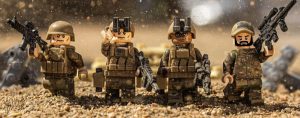It is no myth that first impressions are key to building future relationships. As military veterans and service members, we are all too familiar with the concept that “perception is truth.”
With that in mind, our communication skills can change the dynamics around us in such instrumental ways. The following tips are body-language cues to consider using in situations where verbal cues are limiting, and first impressions are paramount.
1. Smile
Your GENUINE smile — the smile you feel and naturally arrive to because of sheer joy. (The one that lifts your features, folks!) In an interview, be aware of this important component of body language. According to Richard Webster’s “Body Language: Quick and Easy,” smiling at inappropriate times is a common mistake in the interview process. This poor timing of a nervous smile gives you the appearance of being weak, unassertive, and the game-changer: overly nervous. Your interviewer most likely expects you to be a little bit nervous. Focus on the words of your interviewer, and use your genuine smile if something is truly engaging to you.
2. Eye Contact
Make it count! Truly connecting with your interviewer via eye contact not only directs your focus on them and their words; but in your favor, gives you the appearance of confidence, honesty, dependability and responsibility. Engaging in eye contact does NOT mean to stare your interviewer down; this isn’t a face-off. Be physically aware of where you are focusing, and remember to smile when appropriate.
3. Fidgeting
NO! Keep your hands away from your face and hair. Busy hands work, idle hands fuss. Just as though you were engaging in a conversation with a family member or loved one, stay muscularly relaxed. Keep your body “open.” By this, I mean no crossing your legs or arms in front of the body. This is a subconscious message which translates to a defensive position — one that lacks the interest to being open to new ideas.
4. Being Overly Nervous
Yep! You’re naturally going to be a little nervous, so channel this energy into making your interviewer comfortable. People tend to mirror others in their physical intricacies and emotions in an intense situation. Avoid any awkwardness and reach out to shake their hand first (firmly, please, but not too hard). Ask them a direct and confident pleasantry, and actually listen to their response. As a result, you will take the pressure off of the interviewer by being proactively engaged in initiating the interview process.
5. Your Interviewer’s Cues
A few things to gently observe but not overanalyze:
- Your interviewer wants YOU to talk, so they will encourage you to do so with non-verbals such as head nods. A slow head nod is a cue that the individual wants to hear more, but refrain from incessantly chattering. Rapid head nods in succession means: Press on, troop!
- Hand gestures: open palms upward indicate a question or “releasing” a statement outward for the intent to glean a purposeful response.
- Tone of voice: Pitch and vocal inflection are also cues to listen for. “Up” tones, or questioning tones, are a cue to keep talking. “Down” tones, or terminal tones, are a cue for closure.
Last of all, remember that you are human, and that your interviewer is as well. Go in well-rested, with appropriate clothing that fits, and use this arsenal of non-verbal communication skills to get yourself the job!
If you enjoyed this, check out: How to Present your Military Traits in an Interview, and What to Do After the Interview.


